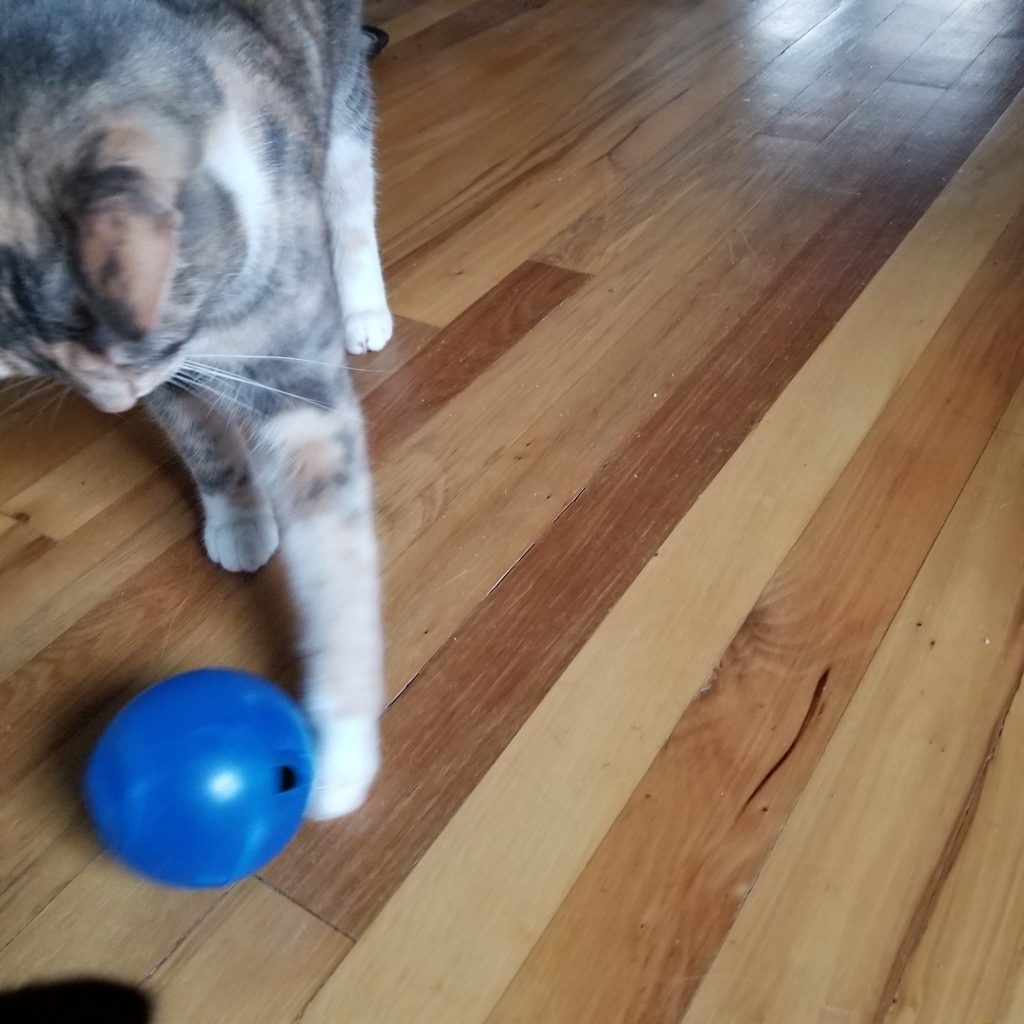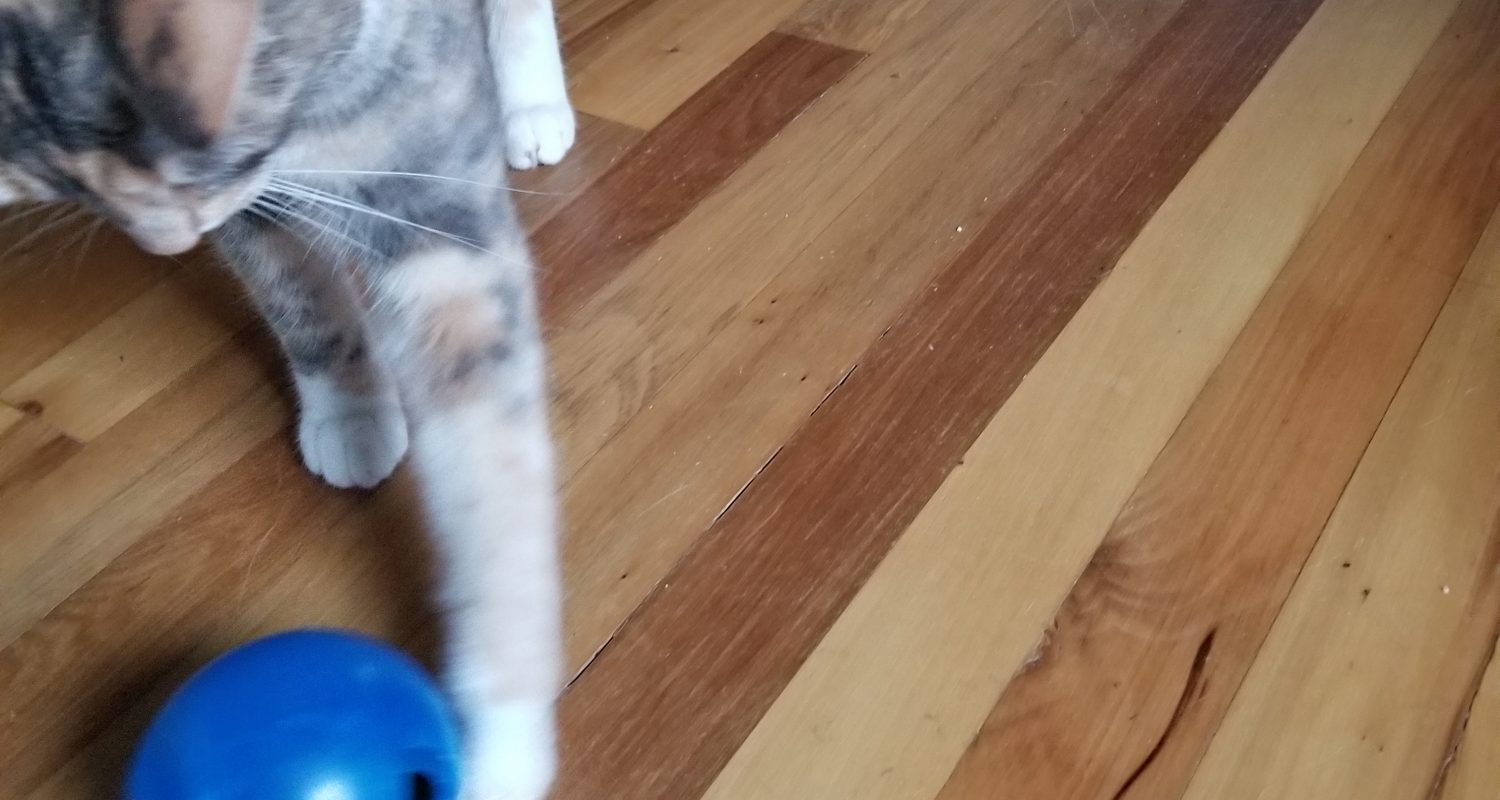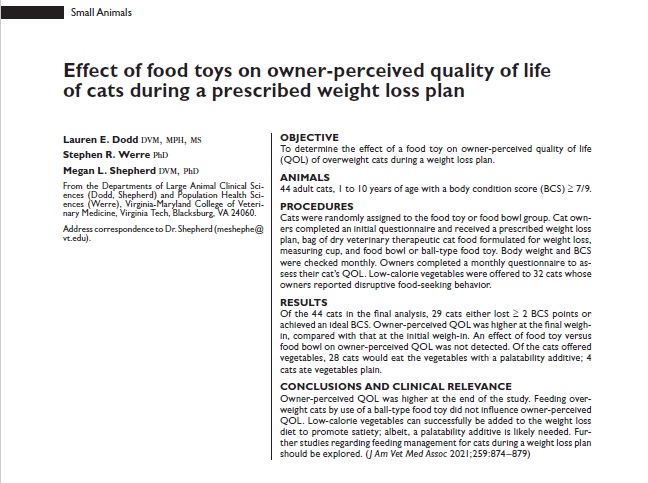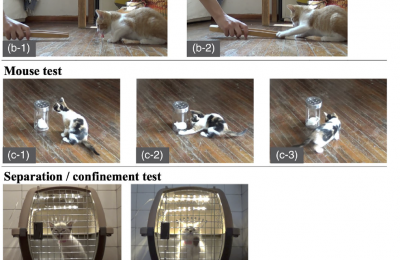You know I love feline food puzzles (aka food toys, foraging toys) – I use them with my own cats and recommend to many of my clients that they use them with their cats. I’ve been a fan for about 20 years, since we were using them in the shelter I worked at. Back then I think there was only one food puzzle for cats available – a pink plastic ball with a small hole in it, which you placed dry food inside. As it was rolled around, dry food would fall out. We saw food puzzles as a way to provide some restless kitties with some mental stimulation and activity while living in the shelter. Nowadays, there are many more options available to meet the needs of just about any cat and food type.
But what are the potential benefits of food puzzles? What does the science say?
A few years ago, some colleagues and I published a review of the use of food puzzles in cats, based heavily on our clinical and consulting experience, as well as on their potential to help resolve behavioral problems. At the time, there was no research specifically testing the effects of their use. Since then, there have been a few studies, all of which I have summarized on my blog: one that found no increase in activity for cats using food puzzles, one that found no effect of food puzzles on reducing hunting behavior in cats with outdoor access, and my own study that found that cats preferred freely available food over that in a food puzzle.
New research on felines & food puzzles
A more recent study, published in the prestigious journal JAVMA, looked at whether the use of a food toy would influence feline weight loss, or on a cat owner’s perception of their cat’s quality of life. The study took place at the Virginia Tech College of Veterinary Medicine, soliciting overweight cats with a body condition score (BCS) of 7 or greater on a 9 point scale. All cats were between 1 and 10 years of age, were healthy enough to be put on a weight loss plan, not on any medications, and accustomed to eating dry food.
What the researchers did
Fifty-five cats were enrolled in the study and randomly assigned to one of two conditions: food toy or food bowl. All cats were placed on the same therapeutic weight loss diet. Owners were asked to fill out a questionnaire at the start of the study and each subsequent month. The questionnaire assessed each cat’s quality of life (QOL) and allowed cat owners to rate their cat’s interest in various activities, such as social activities, playing, eating, and scratching.
Cats were given time to transition to the new diet and for half of the cats, the food toy (the SlimCat Ball). Owners returned to the veterinary clinic monthly for a weight check. Cats stayed in the study until they lost at least 2 points on the body condition score scale, or reached the ideal BCS of 5 out of 9. Cats were in the study varying lengths of time, for around 7-10 months.
Eleven cats were removed from the study due to lack of follow-up, failure to eat the new diet, and similar issues. This left data for 44 cats (23 in the food toy condition, and 21 in the food bowl condition). 24 cats lost at least 2 BCS points, and 14 cats achieved a BCS of 5; however, there no effect of using a food toy. Cats in either group were equally likely to lose weight. There were also no differences in the owner-perceived QOL ratings between the groups, although all owners rating their cat’s QOL as higher at the end of the study compared to beginning ratings. However, owners in both groups ranked eating and drinking as the most important activity for their cats. Further, owners did not associate weight loss with a change in QOL – there were no differences between the cats who lost weight and those who did not.

As a side-note, the researchers planned ahead for feline protests related to calorie restriction: they recommended that cat owners give their cats zucchini, green beans, cauliflower, lettuce, or broccoli, either plain or with a sprinkle of Forti-Flora probiotic powder. Apparently 32 of the 44 cats enjoyed a little vegetable snack to tide them over between meals! (Since reading this study, I have tried, and failed, to get my cats to eat zucchini).
Conclusions
So – the study failed to find an effect of food puzzles on weight loss or cats’ quality of life in either direction. It was revealed that owner compliance in the food toy group was not so great at first. Owners expressed concerns about using them, especially when there were other pets in the home. Owners also reported “food-seeking” behaviors such as meowing, opening cabinets, or eating other pets’ food, often leading owners to give their cats extra food instead of offering veggies.
To conclude, more than 50% of cats in this study were able to lose a significant amount of weight in the study, but there was no additional benefit of using a food toy over offering a therapeutic weight loss diet.
Not giving up yet!
What does this mean for us food puzzle fans? I’m not ready to give up on them yet! Although I am now less certain of some of the benefits of food puzzles (specifically where activity and weight loss are concerned), there is no evidence that when used properly, that food puzzles do any harm. Further, we know from previous research that even in the absence of increased exercise, that environmental enrichment can provide cognitive benefits to animals. I am still hopefully that food puzzles do slow down eating and provide mental stimulation for cats, in ways that can benefit them.
I also think it’s important to introduce food puzzles slowly and carefully, and give cats time to adjust to them. Using treats or a new type of food can make cats a little more interested in them. And if using food puzzles, keep an eye on your cat to make sure they are still eating what they need to stay healthy. If your cat is an enthusiastic eater, they are highly likely to adapt quite quickly to using a food puzzle, and may even enjoy it! (until research proves me wrong!)
Reference
Dodd, L. E., Werre, S. R., & Shepherd, M. L. (2021). Effect of food toys on owner-perceived quality of life of cats during a prescribed weight loss plan. Journal of the American Veterinary Medical Association, 259(8), 874-879.




